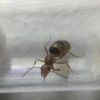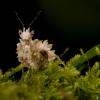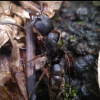- Formiculture.com
- Forums
- Gallery
- Members
- Member Map
- Chat

9 replies to this topic
#1
 Offline
-
Posted April 4 2018 - 2:35 AM
Offline
-
Posted April 4 2018 - 2:35 AM
About a year ago I obtained a Trap-Jaw ant colony that had about 7 workers, I keep them in the test-tube setup with a test tube portal as a small outworld for me to put food in. Since them I have been feeding them crushed crickets but for some reason I haven’t had growth, but degeneration! Now my ant colony is down to only 4 workers, and while there is significantly developed brood, it doesn’t seem like a sufficient amount. I probably made a mistake considering how they were my first ant colony despite not being a begginer-difficulty species. Your tips and help would be greatly appreciated!
#2
 Offline
-
Posted April 4 2018 - 3:38 AM
Offline
-
Posted April 4 2018 - 3:38 AM
I don't prefer feeding crickets to any of my pet insects. I prefer feeding them fruit flies, mealworms, wax worms, and termites(they absolutely cherish them, especially more predaceous species).
Proverbs 6:6-8 New International Version (NIV)
6 Go to the ant, you sluggard;
consider its ways and be wise!
7 It has no commander,
no overseer or ruler,
8 yet it stores its provisions in summer
and gathers its food at harvest.
#3
 Offline
-
Posted April 4 2018 - 5:22 AM
Offline
-
Posted April 4 2018 - 5:22 AM
Do they have a proper substrate to allow for mature larvae to cocoon? If not, they will simply cannibalize larvae that fail to pupate. Workers can sometimes be hesitant to travel long distances to collect this and I find the best success is had in nests where a proper pupation substrate coats the floor. If no new workers are born due to lack of maturing larvae the numbers will fall slowly despite healthy brood production and feeding.
Test tubes will work fine for this species up to a point, but they really need a proper nest to thermoregulate their brood. Cocoons need it dry and warm, while larvae and eggs humid. This is relatively easy to provide in a nest by heating one portion, and then watering the unheated side.
Odontomachus are specialized solo hunters of small insects often scarcely bigger than their own heads. They should be fed small insects regularly. Flightless fruit flies excell for this purpose and form the staple for all of my Odontomachus, but I’ve had good success with cultured flour beetle larvae, roach nymphs, very small mealworms, and non-dangerous wild caught insects. Like MegaMyrmex, I consider crickets a relatively mediocre feeder for ants.
Test tubes will work fine for this species up to a point, but they really need a proper nest to thermoregulate their brood. Cocoons need it dry and warm, while larvae and eggs humid. This is relatively easy to provide in a nest by heating one portion, and then watering the unheated side.
Odontomachus are specialized solo hunters of small insects often scarcely bigger than their own heads. They should be fed small insects regularly. Flightless fruit flies excell for this purpose and form the staple for all of my Odontomachus, but I’ve had good success with cultured flour beetle larvae, roach nymphs, very small mealworms, and non-dangerous wild caught insects. Like MegaMyrmex, I consider crickets a relatively mediocre feeder for ants.
Edited by 123LordOfAnts123, April 4 2018 - 5:24 AM.
#4
 Offline
-
Posted April 4 2018 - 5:51 AM
Offline
-
Posted April 4 2018 - 5:51 AM
Do they have a proper substrate to allow for mature larvae to cocoon? If not, they will simply cannibalize larvae that fail to pupate. Workers can sometimes be hesitant to travel long distances to collect this and I find the best success is had in nests where a proper pupation substrate coats the floor. If no new workers are born due to lack of maturing larvae the numbers will fall slowly despite healthy brood production and feeding.
Test tubes will work fine for this species up to a point, but they really need a proper nest to thermoregulate their brood. Cocoons need it dry and warm, while larvae and eggs humid. This is relatively easy to provide in a nest by heating one portion, and then watering the unheated side.
Odontomachus are specialized solo hunters of small insects often scarcely bigger than their own heads. They should be fed small insects regularly. Flightless fruit flies excell for this purpose and form the staple for all of my Odontomachus, but I’ve had good success with cultured flour beetle larvae, roach nymphs, very small mealworms, and non-dangerous wild caught insects. Like MegaMyrmex, I consider crickets a relatively mediocre feeder for ants.
Alright, I found some peat moss in my garage, filled a test tube with it and added it to the portal. I was considering buying some springtails to help with the dead insects they leave to prevent bacteria and mold. I was also considering buying one of those small omni-nests from Ants-Canada. I'll definitely change their diet to one of your suggestions. Where do you find fruit flies?
Edited by Vuldriel, April 4 2018 - 5:54 AM.
#5
 Offline
-
Posted April 4 2018 - 6:13 AM
Offline
-
Posted April 4 2018 - 6:13 AM
Fruit flies can be found in varying conditions at petco or petsmart, or ordered online. I mostly utilize Drosophila melanogaster; a slightly smaller species with a higher breeding rate than its other commonly cultured counterpart, D. hydei. Commercial breeding media will give you the best production, but for the purpose of feeding ants, a cheap homemade media consisting of potato flakes, vinegar, and yeast will prove sufficient. Recipes vary widely and can easily be found online, as well as culturing instructions.
An Omni-nest should be better than a test tube, but I have no experience with any of these products. I have had excellent results with k-23 firebrick with tunnels carved out using a dremel tool. It’s a good substitute for the ytong material commonly utilized out of country.
As you might’ve discovered by now these are very dirty ants. Their high protein diet makes their poop thick and viscous. To provent obscuring of view, I consider deep, horizontal tunnels essential. As for cleanliness, I use white ant springtails which are specialist ant commensals. You can often find these outside near wild ant nests, often under stone or wood objects.
An Omni-nest should be better than a test tube, but I have no experience with any of these products. I have had excellent results with k-23 firebrick with tunnels carved out using a dremel tool. It’s a good substitute for the ytong material commonly utilized out of country.
As you might’ve discovered by now these are very dirty ants. Their high protein diet makes their poop thick and viscous. To provent obscuring of view, I consider deep, horizontal tunnels essential. As for cleanliness, I use white ant springtails which are specialist ant commensals. You can often find these outside near wild ant nests, often under stone or wood objects.
Edited by 123LordOfAnts123, April 4 2018 - 6:16 AM.
#6
 Offline
-
Posted April 4 2018 - 6:21 AM
Offline
-
Posted April 4 2018 - 6:21 AM
Fruit flies can be found in varying conditions at petco or petsmart, or ordered online. I mostly utilize Drosophila melanogaster; a slightly smaller species with a higher breeding rate than its other commonly cultured counterpart, D. hydei. Commercial breeding media will give you the best production, but for the purpose of feeding ants, a cheap homemade media consisting of potato flakes, vinegar, and yeast will prove sufficient. Recipes vary widely and can easily be found online, as well as culturing instructions.
An Omni-nest should be better than a test tube, but I have no experience with any of these products. I have had excellent results with k-23 firebrick with tunnels carved out using a dremel tool. It’s a good substitute for the ytong material commonly utilized out of country.
As you might’ve discovered by now these are very dirty ants. Their high protein diet makes their poop thick and viscous. To provent obscuring of view, I consider deep, horizontal tunnels essential. As for cleanliness, I use white ant springtails which are specialist ant commensals. You can often find these outside near wild ant nests, often under stone or wood objects.
Wait so you keep and breed fruit flies like some people do with termites to feed your ants? That's a good cost-effective idea. I'm thinking that I'll get the small vertical omni-nest for my birthday in August, but I'll get springtails and flies this week. I can just put them in with the ants in their little tubes right? I know ants generally leave them alone.
#7
 Offline
-
Posted April 4 2018 - 6:52 AM
Offline
-
Posted April 4 2018 - 6:52 AM
Fruit flies are essential for keeping ants. The wingless varieties are the easiest to keep and feed with. Flightless fruit flies can’t fly (when kept under 80 degrees) but they can still jump and glide a short distance.Wait so you keep and breed fruit flies like some people do with termites to feed your ants? That's a good cost-effective idea. I'm thinking that I'll get the small vertical omni-nest for my birthday in August, but I'll get springtails and flies this week. I can just put them in with the ants in their little tubes right? I know ants generally leave them alone.Fruit flies can be found in varying conditions at petco or petsmart, or ordered online. I mostly utilize Drosophila melanogaster; a slightly smaller species with a higher breeding rate than its other commonly cultured counterpart, D. hydei. Commercial breeding media will give you the best production, but for the purpose of feeding ants, a cheap homemade media consisting of potato flakes, vinegar, and yeast will prove sufficient. Recipes vary widely and can easily be found online, as well as culturing instructions.
An Omni-nest should be better than a test tube, but I have no experience with any of these products. I have had excellent results with k-23 firebrick with tunnels carved out using a dremel tool. It’s a good substitute for the ytong material commonly utilized out of country.
As you might’ve discovered by now these are very dirty ants. Their high protein diet makes their poop thick and viscous. To provent obscuring of view, I consider deep, horizontal tunnels essential. As for cleanliness, I use white ant springtails which are specialist ant commensals. You can often find these outside near wild ant nests, often under stone or wood objects.
I’d reccomend the hybrid nest series - I’m not sure how smooth the plastic is in the vertical nests, and Odontomachus are rather poor climbers.
Regarding the springtails, Kyle at Roachcrossing is the only person I know who has ant springtails available. There are many species of cultured springtail and the vast majority are unsuited to living in close proximity of ants. Though again, they’re not too hard to find here in Florida.
Edited by 123LordOfAnts123, April 4 2018 - 6:54 AM.
#8
 Offline
-
Posted April 4 2018 - 3:14 PM
Offline
-
Posted April 4 2018 - 3:14 PM
They are quite fond of termites.
- LC3 likes this
#9
 Offline
-
Posted April 4 2018 - 7:24 PM
Offline
-
Posted April 4 2018 - 7:24 PM
I think the previous advice of fruit flies and termites (if you can find them) are great. Also, make sure you have substrate available-as lordofants suggested. This means dirt or sand. Good luck.
#10
 Offline
-
Posted April 4 2018 - 10:36 PM
Offline
-
Posted April 4 2018 - 10:36 PM
wooo good info, i just caught trap jaw ant queen n now she have 3 eggs
Colony:
2 Odontomachus aciculatus
2 Polyrachis Dives
3 Camponotus sp
Also tagged with one or more of these keywords: trap-jaw, odontomachus bruennus
Ant Keeping →
Ant Keeping Journals →
FloridaAnt’s Odontomachus sp. JournalStarted by FloridaAnts , Jul 26 2022 |
|

|
||
Market Place →
General Market Place →
Selling Odontomachus Monticola QueensStarted by PiotrSioda , Jun 6 2021 |
|

|
0 user(s) are reading this topic
0 members, 0 guests, 0 anonymous users














